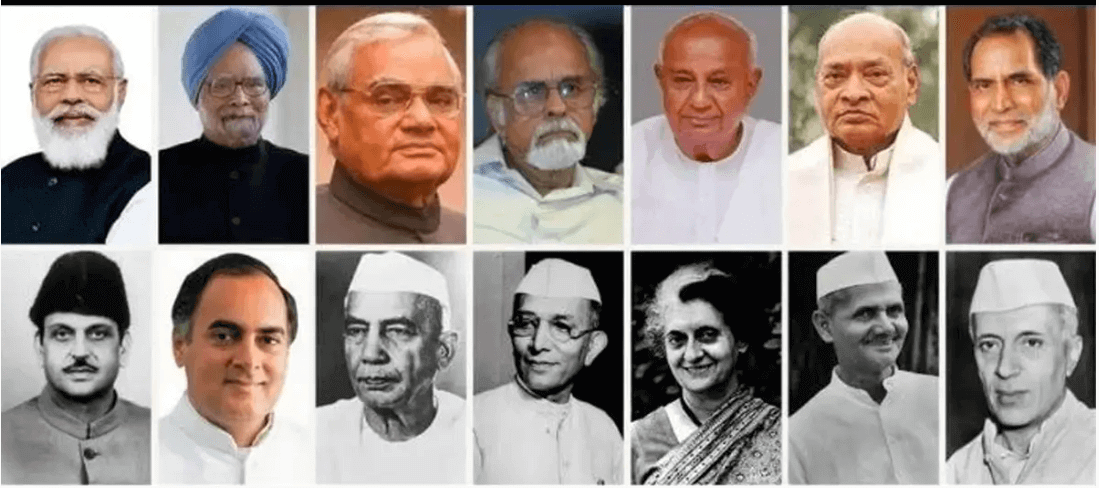List of all Prime Minister of INDIA (1947 - 2023)
Introduction:
India, the world's largest democracy, has been guided by a succession of visionary leaders since gaining independence in 1947. This article takes you on a chronological journey through the prime ministers who have shaped India's destiny, each bringing their unique leadership and contributions to the nation's growth and development.
Certainly, here's a list of all the Prime Ministers of India in table format:
| No. | Prime Minister | Term |
|---|---|---|
| 1 | Jawaharlal Nehru | 1947-1964 |
| 2 | Gulzarilal Nanda (Acting) | 1964, 1964-1966 |
| 3 | Lal Bahadur Shastri | 1964-1966 |
| 4 | Indira Gandhi | 1966-1977, 1980-1984 |
| 5 | Morarji Desai | 1977-1979 |
| 6 | Charan Singh | 1979-1980 |
| 7 | Rajiv Gandhi | 1984-1989 |
| 8 | Vishwanath Pratap Singh | 1989-1990 |
| 9 | Chandra Shekhar | 1990-1991 |
| 10 | P.V. Narasimha Rao | 1991-1996 |
| 11 | Atal Bihari Vajpayee | 1996, 1998-2004 |
| 12 | H.D. Deve Gowda | 1996-1997 |
| 13 | Inder Kumar Gujral | 1997-1998 |
| 14 | Manmohan Singh | 2004-2014 |
| 15 | Narendra Modi | 2014-Present |
This table provides a concise overview of India's Prime Ministers and their respective terms in office.
1947 - 1964: Jawaharlal Nehru
Jawaharlal Nehru, affectionately known as "Panditji," was the first Prime Minister of independent India. He was a close associate of Mahatma Gandhi and played a pivotal role in the freedom struggle. Nehru's leadership laid the foundation for India's democratic values and secularism. He championed the principles of non-alignment in foreign policy and laid the groundwork for the nation's industrial and scientific growth.
1964 - 1966: Gulzarilal Nanda (Acting)
Gulzarilal Nanda served as the Acting Prime Minister twice, following the deaths of Jawaharlal Nehru and Lal Bahadur Shastri. During his short tenures, he focused on maintaining stability and continuity in government.
1966 - 1977: Indira Gandhi
Indira Gandhi, the first woman Prime Minister of India, held office for a total of four terms. Her tenure witnessed significant events, including the Green Revolution, Bangladesh Liberation War, and the declaration of a state of emergency. Her leadership style was marked by both remarkable achievements and controversies.
1977 - 1979: Morarji Desai
Morarji Desai was the first non-Congress Prime Minister of India. He implemented economic and fiscal policies that aimed at reducing government intervention and promoting individual freedoms. His tenure was marked by the restoration of civil liberties following the emergency.
1979 - 1984: Charan Singh
Charan Singh was a renowned agricultural economist and briefly served as India's Prime Minister. His focus was on rural and agricultural development, and he played a crucial role in addressing farmers' concerns.
1984 - 1989: Rajiv Gandhi
Rajiv Gandhi succeeded his mother, Indira Gandhi, as Prime Minister and focused on modernization, technological advancement, and economic reforms. His leadership was tragically cut short by his assassination in 1991.
1989 - 1990: Vishwanath Pratap Singh
V.P. Singh, a social justice advocate, led a coalition government and initiated several progressive measures, including the implementation of the Mandal Commission recommendations to provide reservation for Other Backward Classes (OBCs).
1990 - 1991: Chandra Shekhar
Chandra Shekhar briefly held the position of Prime Minister and was known for his efforts to form a government with outside support.
1991 - 1996: P.V. Narasimha Rao
P.V. Narasimha Rao's tenure marked a significant turning point for India. His administration initiated economic liberalization, which transformed the Indian economy. His government also navigated through challenging times, including the demolition of the Babri Masjid.
1996: Atal Bihari Vajpayee (First Term)
Atal Bihari Vajpayee served a brief term as Prime Minister in 1996. He was known for his oratory skills and commitment to a strong, self-reliant India.
1996 - 2004: H.D. Deve Gowda and Inder Kumar Gujral
H.D. Deve Gowda and Inder Kumar Gujral served short stints as Prime Ministers, heading coalition governments.
2004 - 2014: Manmohan Singh
Manmohan Singh's tenure was marked by economic growth and social welfare programs. He played a pivotal role in strengthening India's relations with the United States and other global powers.
2014 - Present: Narendra Modi
Narendra Modi, the current Prime Minister, has been at the forefront of India's rapid economic growth and has introduced several flagship initiatives, including "Make in India" and "Swachh Bharat Abhiyan." His leadership is marked by a proactive approach to international diplomacy and a focus on infrastructure development.
Conclusion:
India's prime ministers have played a critical role in shaping the nation's history, governance, and development. From Jawaharlal Nehru to Narendra Modi, each leader brought their unique vision and contributions to the table, leaving an indelible mark on the diverse tapestry of India's political landscape.


